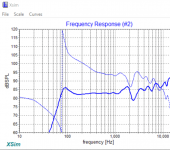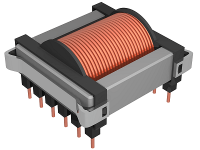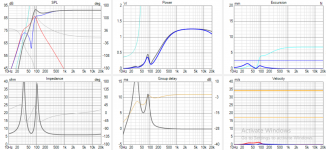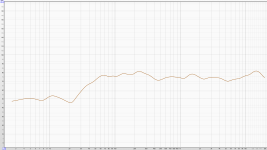Hello there.
Cannot find inductance locally. Where to get iron core for a 36mH one?
I need to do a passive high-pass for a full range speaker design. Pointers to already-made al welcome, but I can measure inductance so I am not afraid to wind a coil.
Thanks!
Cannot find inductance locally. Where to get iron core for a 36mH one?
I need to do a passive high-pass for a full range speaker design. Pointers to already-made al welcome, but I can measure inductance so I am not afraid to wind a coil.
Thanks!
Disassemble a small power transformer with E and I laminations. Stack all the I pieces together and start winding.Where to get iron core for a 36mH one?
Wind a few hundred turns of scrap wire (perhaps what you took off) to figure how much I and R you get for so many turns. Re-figure (remember to square) to get 36mH at a reasonably low resistance.
Thanks!
I ordered the I laminations for the attached image, I ordered #28. I will definitely try this and I can 3d-print a thing wrapper for the core.
I also ordered this one for testing. I understand that for 10W it should work.
https://www.amazon.com/gp/product/B07FK8FSBT/
Thanks!
I ordered the I laminations for the attached image, I ordered #28. I will definitely try this and I can 3d-print a thing wrapper for the core.
I also ordered this one for testing. I understand that for 10W it should work.
https://www.amazon.com/gp/product/B07FK8FSBT/
Thanks!
Attachments
Yes!
In simulations there's a peak I see (if I don't add a resistance to the RCL filter) and I wonder if it will be an issue.
After the first image, there's the Xsim output for a PS95-8. I see the same peak. I'm actually interested in a filter for the W5-2143 but I also have PS95 around and the files for the Xsim simulation for the PS95. I got the suggestion from this page.



With 10 Ohm resistance:



In simulations there's a peak I see (if I don't add a resistance to the RCL filter) and I wonder if it will be an issue.
After the first image, there's the Xsim output for a PS95-8. I see the same peak. I'm actually interested in a filter for the W5-2143 but I also have PS95 around and the files for the Xsim simulation for the PS95. I got the suggestion from this page.
Best Answer: For a second-order 50 Hz high-pass at 8 ohms, it would be a capacitor at 281 uf and a coil rated for 36 mH. Or as close to those values as you can get with off-the-shelf parts.
With 10 Ohm resistance:
Attachments
That's a great suggestion....there is a real paucity of high inductance coils (from the usual suspects like parts-express). (Will suggest in the Solstice thread I started, with proper attribution).Disassemble a small power transformer with E and I laminations. Stack all the I pieces together and start winding.
Wind a few hundred turns of scrap wire (perhaps what you took off) to figure how much I and R you get for so many turns. Re-figure (remember to square) to get 36mH at a reasonably low resistance.
36mH? That's a big inductor for a crossover. Are you making a 2nd order high pass at 50Hz?
Michael beat me to that question.
dave
Thanks. Like in the image below I guess. Lots of things to try!If you use the E laminations rather than the I’s you end up with a more “efficient” inductor in terms of DCR per mH. And you can re-use the bobbin from the donor transformer. Perhaps the wire too. This is where my recycled magnet wire ends up.
Attachments
Do you have a load on the filter? The 40dB peak suggests you don't. Try 8 Ohm load.there's a peak I see
BUT then try the wicked resonance of a real loudspeaker. 6r below resonance, 8r at 400Hz, but maybe 50r at resonance. If resonance happens to be 50Hz then you are halfway to the unloaded case at the most important frequency.
For more fun: we were reminded this weekend that all loudspeaker "constants" change with drive level, maybe radically. (On top of stiffness being all over the place as the suspension breaks-in and absorbs moisture, and the MMF decaying over the years... mass is semi-constant but we were told of a cone becoming more stable with a sealer.)
IMHO it is folly to expect a high performance 50Hz high-pass in passive. But as a DIY project,why not?
For more fun: we were reminded this weekend that all loudspeaker "constants" change with drive level, maybe radically.
Oh, a reason to listen to them close to the published specs and not above.
IMHO it is folly to expect a high performance 50Hz high-pass in passive. But as a DIY project,why not?
Well, the idea is to make the DIY as good as possible 🙂 The reason for me wanting a passive filter is that I'll be giving away a few speakers and I cannot control all what the recipient will do. DSP increases the cost a bit as I would need a separate Bluetooth module. So far I've been happy with ZK-1002T.
I don't use Bluetooth myself, but the recipients will want it.
What DSP would you recommend? I've used software EQs so far. This DSPB-K from Dayton seems easy to use but I don't know what is the order of the default filter config. Projects are published, I'll have to check them.
I'm not aware of any actually good post-amplification DSPs but if you are making a packaged unit.... some of the Dayton/Wondom/Sure (literally all the same, just different branding) amp boards couple a class-D w/ onboard DSP. You could mnake the DSP 'program', flash it to everything with a single programmer, and then if people want to muck about with DSP later, they can buy their own programmer and re-flash.
I was considering rebuilding my passive xovers from some DIYSG Fusion 10's I assembled 10 years ago and just wound up going DSP active with bi-amp on each speaker. I cannot go back. Highly recommended if project/budget allows. For me, it was less expensive that getting stuff of quality levels I desired in passive components. May be different if you have a bunch of parts on hand.
I was considering rebuilding my passive xovers from some DIYSG Fusion 10's I assembled 10 years ago and just wound up going DSP active with bi-amp on each speaker. I cannot go back. Highly recommended if project/budget allows. For me, it was less expensive that getting stuff of quality levels I desired in passive components. May be different if you have a bunch of parts on hand.
If I understood correctly: Scott Hinson in Saturday's session was teaching that parameters can change a LOT long before "rating" is reached. However, wait and watch the presentation replay yourself (perhaps a few weeks).close to the published specs and not above.
Nice, it would be nice to see that.If I understood correctly: Scott Hinson in Saturday's session was teaching that parameters can change a LOT long before "rating" is reached. However, wait and watch the presentation replay yourself (perhaps a few weeks).
I got a suggestion from Parts Express for the W5-2143. The DS135-PR Passive Radiator, in yellow below. Green is ported and blue is sealed.
OTOH I simulated another high-pass with VituixCad and it looks interesting. Applied to ported scenario. At 42Hz.
No filter.
With the filter above. Excursion doesn't go beyond the 2.5. Looks interesting, but I don't know if this kind of filter has other implications or whether it's OK to use it.
Attachments
So, I tried adding a ported sub and I think I like it. From what I've read building a 2-way speaker with more than one amp is a good way to go. Green line after just a bit of EQ.

Something I feel is that with the sub I enjoy music with less volume. Bass lines are fun.
Now, I tested adding the high pass described in the previous post to the sub because it gets distortion with some songs (Dayton Audio LW150-4 6). I have three of those and I plan to compare sealed, ported and 4th order band-pass. The idea is to protect the sub from over-extrusion. When I got those I though that minimizing volume was very important but now I realize that 30lts isn't much.
In a quick measure and with no EQ I get this. IMHO it helps with a goal: seal the FR speakers(Tang Band W3-2141 3") and tune down the bass they get. The song that sounds bad because of sub distortion sounds better (Boom Boom Pow). I have a few songs for testing so that I can compare subjectively 🙂

Now a new window opens: phases when you use filters. I don't know anything about that other than cancellation when you wire speakers wrong. I think I need to learn about that. Also, I think that graph above doesn't look too different from what I would get with the sub in a sealed box. I even have it already but I haven't measured.
Feedback welcome!
Something I feel is that with the sub I enjoy music with less volume. Bass lines are fun.
Now, I tested adding the high pass described in the previous post to the sub because it gets distortion with some songs (Dayton Audio LW150-4 6). I have three of those and I plan to compare sealed, ported and 4th order band-pass. The idea is to protect the sub from over-extrusion. When I got those I though that minimizing volume was very important but now I realize that 30lts isn't much.
In a quick measure and with no EQ I get this. IMHO it helps with a goal: seal the FR speakers(Tang Band W3-2141 3") and tune down the bass they get. The song that sounds bad because of sub distortion sounds better (Boom Boom Pow). I have a few songs for testing so that I can compare subjectively 🙂
Now a new window opens: phases when you use filters. I don't know anything about that other than cancellation when you wire speakers wrong. I think I need to learn about that. Also, I think that graph above doesn't look too different from what I would get with the sub in a sealed box. I even have it already but I haven't measured.
Feedback welcome!
Attachments
Last edited:
- Home
- Design & Build
- Parts
- Cannot find inductance locally. Where to get iron core for a 36mH one?





